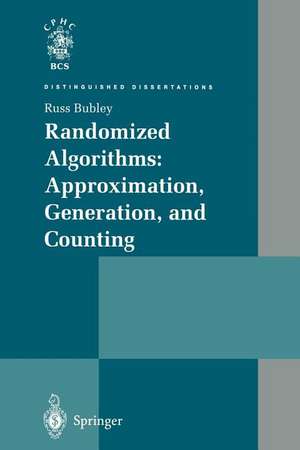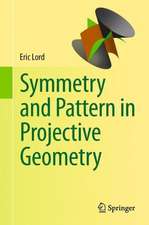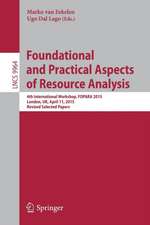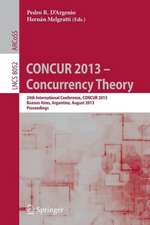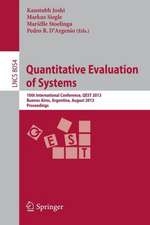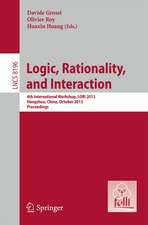Randomized Algorithms: Approximation, Generation, and Counting: Distinguished Dissertations
Autor Russ Bubleyen Limba Engleză Paperback – 16 sep 2011
Din seria Distinguished Dissertations
- 20%
 Preț: 290.51 lei
Preț: 290.51 lei - 15%
 Preț: 633.68 lei
Preț: 633.68 lei - 15%
 Preț: 645.47 lei
Preț: 645.47 lei - 20%
 Preț: 654.05 lei
Preț: 654.05 lei - 20%
 Preț: 647.79 lei
Preț: 647.79 lei - 20%
 Preț: 994.92 lei
Preț: 994.92 lei - 20%
 Preț: 648.26 lei
Preț: 648.26 lei - 20%
 Preț: 328.60 lei
Preț: 328.60 lei - 20%
 Preț: 641.34 lei
Preț: 641.34 lei - 20%
 Preț: 328.09 lei
Preț: 328.09 lei - 20%
 Preț: 325.30 lei
Preț: 325.30 lei - 20%
 Preț: 926.94 lei
Preț: 926.94 lei - 20%
 Preț: 640.69 lei
Preț: 640.69 lei - 20%
 Preț: 603.37 lei
Preț: 603.37 lei - 20%
 Preț: 637.56 lei
Preț: 637.56 lei - 20%
 Preț: 643.30 lei
Preț: 643.30 lei - 20%
 Preț: 640.51 lei
Preț: 640.51 lei - 20%
 Preț: 640.19 lei
Preț: 640.19 lei - 20%
 Preț: 325.63 lei
Preț: 325.63 lei
Preț: 639.52 lei
Preț vechi: 799.41 lei
-20% Nou
Puncte Express: 959
Preț estimativ în valută:
122.39€ • 132.89$ • 102.80£
122.39€ • 132.89$ • 102.80£
Carte tipărită la comandă
Livrare economică 22 aprilie-06 mai
Preluare comenzi: 021 569.72.76
Specificații
ISBN-13: 9781447111801
ISBN-10: 144711180X
Pagini: 176
Ilustrații: XX, 152 p.
Dimensiuni: 155 x 235 x 9 mm
Greutate: 0.25 kg
Ediția:Softcover reprint of the original 1st ed. 2001
Editura: SPRINGER LONDON
Colecția Springer
Seria Distinguished Dissertations
Locul publicării:London, United Kingdom
ISBN-10: 144711180X
Pagini: 176
Ilustrații: XX, 152 p.
Dimensiuni: 155 x 235 x 9 mm
Greutate: 0.25 kg
Ediția:Softcover reprint of the original 1st ed. 2001
Editura: SPRINGER LONDON
Colecția Springer
Seria Distinguished Dissertations
Locul publicării:London, United Kingdom
Public țintă
ResearchCuprins
1 Mathematical Background.- 1.1 Computational Complexity.- 1.2 Probability.- 1.3 Markov Chains.- 1.4 Graph Theory.- 2 Techniques for Sampling and Approximate Sampling.- 2.1 Introduction.- 2.2 Direct Sampling.- 2.3 Markov Chain Method.- 3 Approximate Counting.- 3.1 Parsimonious Reductions.- 3.2 Counting Directly.- 3.3 Counting and Sampling.- 3.4 The Markov Chain Monte Carlo Method.- 4 Applications: Coupling.- 4.1 Hypergraph Colourings.- 4.2 Sink-Free Graph Orientations and Twice-Sat.- 4.3 Log-Concave Sampling, and the Volume of a Convex Body.- Intermezzo: Path Coupling.- 5 Applications: Path Coupling.- 5.1 Introduction.- 5.2 Twice-Sat Revisited.- 5.3 Sink- and Source-Free Graph Orientations.- 5.4 Totally Edge Cyclic Orientations.- 5.5 Independent Sets: The Conserved Hard-Core Model.- 5.6 Independent Sets: The Non-Conserved Hard-Core Model.- 5.7 Linear Extensions of a Partial Order.- 5.8 Graph Colouring.- 5.9 The Extended Potts Framework.- 5.10 Graph Colouring Revisited.- 6 Directions for Future Work.- 6.1 Breaking Thresholds.- 6.2 Beyond Self-Reducibility.- 6.3 Mixed Methods for Approximate Counting.- 6.4 Faster Reductions from Approximate Counting to Approximate Sampling.- 6.5 Anti-ferromagnetic Models.- 6.6 Log-Concave Sampling via Path Coupling.- Appendices.- A An Application of Dobrushin’s Uniqueness Criterion.- B A Hierarchy of #SAT Restrictions.- B.1 Introduction.- B.2 A Summary of Known Results.- B.2.1 Easy Exact Counting.- B.2.2 Hard Exact Counting.- B.2.3 Easy Approximate Counting.- B.2.4 Hard Approximate Counting.- B.3 Summary and Conclusions.- C Equivalence of Transposition Distance to Spearman’s Footrule.
